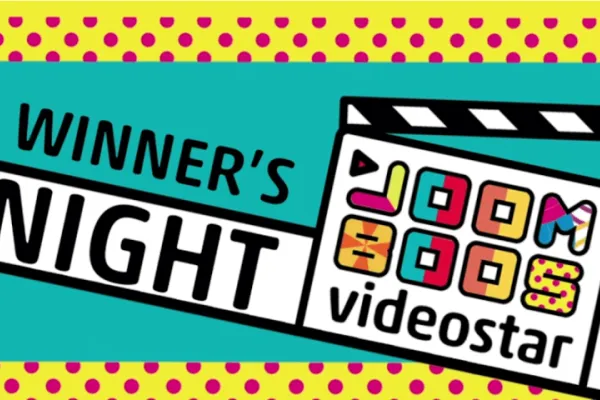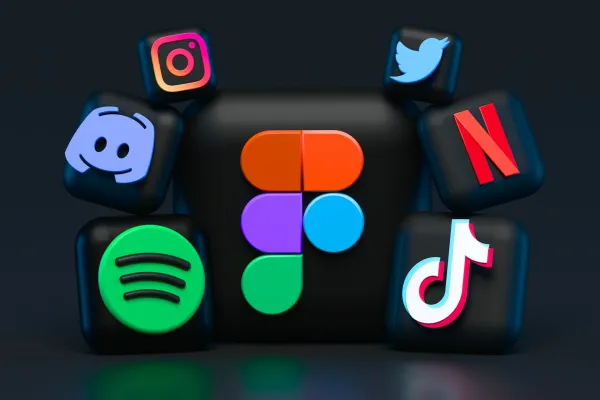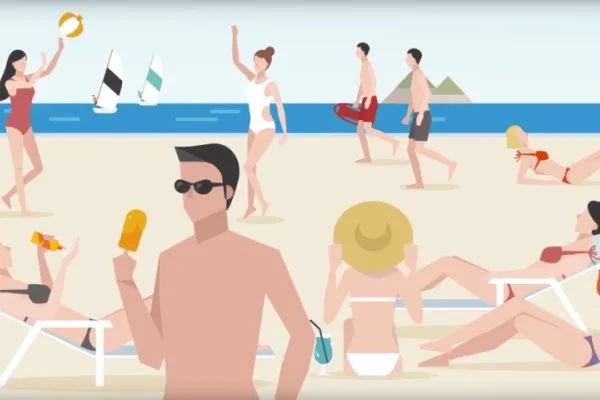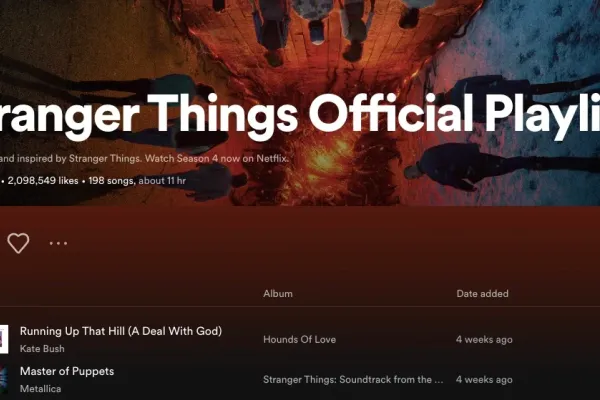 Details
Details
The beauty of native advertising lies in its versatility. Through creative approaches across various platforms and mediums, brands and publishers with native ads have found clever, funny, and interesting ways to connect with audiences.
Native advertising has evolved significantly over the decades since its dawn in radio programs of the 1920s the so-called soap operas because they were often sponsored by soap companies.
Modern native advertising has, with help from the internet, evolved into a success story because of its ability to provide value for both brand and audience. And it's still evolving according to leading industry experts.
In this article, we've collected the 12 best native advertising examples in 2025 so far showcasing how the creativity, effectiveness, and adaptability of native ads can be used to get a story across.
📥 New E-Book! The Tech Stack Used by Native Ad Pros
Download the Branded Content Tech Stack 2025—120+ native ad tools, expert commentary, and exclusive case studies.
12 Best Native Advertising Examples 2025 [clickable table of contents]
- Native Advertising Example 1: Elle and DOVE
- Native Advertising Example 2: American City Business Journals and Platinum Bank
- Native Advertising Example 3: Storybook and Stimorol
- Native Advertising Example 4: 01 Content & Technology - C3 Croatia and Coolinarika
- Native Advertising Example 5: Content Studio CNC and Heluz
- Native Advertising Example 6: National Post and Ceros
- Native Advertising Example 7: Večernji list d.o.o. and Multiple partners
- Native Advertising Example 8: N365 and NMDP
- Native Advertising Example 9: T Brand Studio and Birkenstock
- Native Advertising Example 10: The Globe Content Studio and Intuit TurboTax
- Native Advertising Example 11: Axel Springer and Coca-Cola
- Native Advertising Example 12: BBC Storyworks and Monash Business School
Types of Native Ads in 2025
But before you dive into the best examples of native advertising in 2025, let's have a quick overview of what types of native ads are available in 2025.
With so many difficult ways of using native advertising, it's important to understand that each type of native advertising has its unique format and purpose, and its advantages and disadvantages.
The Native Advertising Institute has identified five core types of native advertising:
- In-Feed/In-Content
- Content Recommendation Ads
- Search Ads
- Promoted Listings
- Branded/Native Content (including advertorials)
1. In-Feed/In-Content
The difference between in-feed native ads and in-content native ads is where they live.
In-feed native ads live within the regular content of a website or app. Users encounter these ads as in-feed units in their news feed of social media feeds. They'll often be labeled as "sponsored" or "promoted" and consist of either static images or videos.
In-content native ads live within a single piece of content for example a news article. It can appear between paragraphs or after the conclusion of the article.
2. Content Recommendation Ads
Content recommendation ads are typically also known as content recommendation widgets.
These widgets most often live at the bottom of news articles or content pages and provide the user with a list of related articles. They're typically labeled "sponsored" or "promoted".
These ads are also often referred to as content discovery ads or sponsored content ads. They'll always send the user to an external site.
3. Search Ads
Search ads are also known as paid search ads and they appear at the top of a user's search results.
They’re used both for search engine marketing and within search results for individual domains.
The appearance of search ads depends on the content and format of the search engine used, but native search ads all present their content in a layout that mimics organic search results.
4. Promoted Listings
Promoted listings are generally found on pages that don't have editorial content. They are often used by e-commerce sites to feature sponsored products on a category page.
These ads still fit into the browsing environment because they look nearly identical to other products or services on a given site. Promoted listings appear in-stream and match the page function.
5. Branded/Native Content
Branded or native content is paid content from a brand that is published in the same format as a full editorial on a publisher’s site, generally in conjunction with the publisher's content teams themselves.
Many times the content, whether it’s a written article or a video, will be produced by the publisher. Some leading publishers, including the New York Times, Buzzfeed, Fortune and Washington Post, to name just a few, have their own in-house studios that produce native content with a journalistic angle.
This helps to ensure that the native content will meet the publisher’s expectations and those of its loyal audience.
12 Examples of Native Advertising [2025 Updated]
Native Ad Example 1: ELLE and DOVE
"Livet under armen" (meaning Life under the Arm) is not just an advert collaboration but an excellen example of a native advertising campaign that helps redefine the norms of the beauty industry – with a perfect balance between creativity and effectiveness.
Fashion magazine ELLE and personal care brand DOVE to create awareness and knowledge about a new line of deodorants, with an emphasis on "Kindness to skin formula" and "Protects against sweat".
The overall goal of the campaign was to create a greater understanding of "Livet under armen" and lift the taboo surrounding the female armpit and at the same time strengthen the self-esteem of the target group.
To achieve this goal, ELLE and DOVE created a campaign together with Swedish-Finnish actress Bianca Kronlöf. The campaign was presented via a statement video in ELLE and as a digital native article on ELLE.se.
In the campaign, Bianca Kronlöf opens up and talks about taboos around the armpit, how we are affected by beauty ideals, and what we can do to normalize the armpit. To broaden the reach of the campaign, it was also launched on social media.
This is a great example of native advertising that does not only have hard goals in mind. The strength of the campaign is that it not only introduced a product perfectly but also created a dialogue about body image and self-esteem through the concept. By going beyond traditional product marketing, the campaign has created added value for the target audience. It has encouraged women to embrace their uniqueness, thereby creating a meaningful and positive interaction between brand and consumer.
Native Ad Example 2: American City Business Journals and Platinum Bank
In this native advertising example, Minneapolis/St. Paul Business Journal partnered with Platinum Bank to record and produce a co-branded podcast series with area business leaders. The podcast series "Off the Record" features Kathy Robideau, market president and publisher of Minneapolis/St. Paul Business Journal, and Dave Faust, CEO and president of Platinum Bank.
The conversational podcast features robust conversations with well-known business leaders as they share pivotal moments in their lives, career highlights, and goals for the coming years. It dives into the career journeys, drives meaningful discussions, and creates a lead gen opportunity to turn guests into potential business banking clients.
Platinum Bank chose the podcast approach to help elevate its brand awareness and build strategic relationships with area business leaders in a relaxed, conversational environment.
Platinum Bank managed to achieve its three objectives with the podcast campaign: 1) to grow its network of high-profile business leaders, to build relationships and add to its business clientele 2) to enhance its brand exposure and awareness and 3) to build out a robust library of evergreen content that can be leveraged outside the campaign’s promotional period.
Native Ad Example 3: Storybook and Stimorol
Summer, good vibes, music, and festivals undeniably go hand in hand. Gum manufacturer Stimorol knows this well and during the spring and summer of 2023.
They facilitated a music competition where participants could win tickets to music events such as the Danish festivals Smukfest and Grøn. By scanning the QR code on their classic and well-known 3-packs of gum, one could win festival tickets every day throughout the entire period.
To create buzz and get people to participate in the competition Stimorol in collaboration with Storybook created a native advertising campaign that had two primary tasks:
- Create awareness about the music competition
- Create awareness about Stimorol in general forming top-of-mind association for consumers, so chewing gum became synonymous with Stimorol – and Stimorol became synonymous with music and good vibes.
To create awareness about Stimorol's music competition, it was important to publish content in the period leading up to and during the festival Smukfest, allowing the Stimorol brand to naturally tap into the music, entertainment, and positive atmosphere.
For this purpose, Storybook and Stimorol chose an influencer strategy with profiles that resonate with the young audience of Generation Z and whose audience actively engages with the content they are exposed to.
To create as much authenticity and relevance among the followers as possible, the influencers were asked to put their own creative spin on how they would brand Stimorol and its music competition – all while keeping in mind the goal of building brand awareness and promoting the competition.
Watch the video below for more info on this native advertising example.
Native Ad Example 4: 01 Content & Technology - C3 Croatia and Coolinarika
Croatia is Europe's most obese nation. 65% of adults and 35% of children are dealing with overweight issues. Experts and officials are raising the alarm: the root causes are insufficient physical activity coupled with a particulate taste for bakery products and sweets.
Coolinarika, the largest regional culinary platform with +700,000 monthly users and +200,000 recipes, owned by the largest regional food company Podravka, wanted to step in with a two-fold mission: to utilize a strong dataset on healthy eating to help the community and implement a strategic vision to connect with Generation Z, who are steering the course of new food trends towards a healthier future.
Coolinarika gave 01 Content & Technology - C3 Croatia this challenge: how can Coolinarika empower its users, especially Gen Z, to make healthier food choices with the help of generative AI technology?
Together with 01 Content & Technology - C3 Croatia Coolinarika created the first virtual assistant SuperFoodChef in the region for nutritionally balanced diets guided by artificial intelligence based on the GPT-3.5 OpenAI model.
SuperFoodChef will give information on why nutritionally rich foods are important and introduce consumers to useful superfood recipes on Coolinarika that are easy to prepare and super tasty.
At the moment, SuperFoodChef's knowledge base includes information on 100 nutritionally valuable foods and 500 recipes, and I will continuously improve. In just 100 days SuperFoodChef has become the most popular AI-powered assistant in the region with 101,000 users and more than 340,000 messages have been exchanged – a great example of how AI can be used to create unique native advertising.
Native Ad Example 5: Content Studio CNC and Heluz
Czech company HELUZ manufactures a comprehensive brick system for passive houses and buildings with almost zero energy consumption. The subsidiary HELUZ IZOS produces modern window glazing eliminating outside noise, heat, or cold from homes.
Their products are well-known by their B2B partners, but with this native advertising example HELUZ wanted to grab the attention of ordinary house owners. Specifically, HELUZ still needed to reach out to individuals who are considering building a family home. Therefore the brand awareness campaign aimed to reach the middle class aged 30+.
The goal of the long-term cross-media campaign was to propose an energy-saving solution to readers, that allows them to save money in the long term. It was about explaining the complex issue of house construction/reconstruction in a comprehensible way.
In addition to clear text Content Studio CNC worked with playful graphic elements across formats. A huge benefit to this approach was that readers could read comprehensive information in an easily digestible format without having to search for it in multiple places.
Native Ad Example 6: National Post and Intact Insurance
Intact Insurance wanted to further its position as a leader in Canada for auto insurance to the audience of the National Post. Intact Insurance aimed to spread the message that they are their customers’ partners in managing their lifestyles.
They partnered with Content Works the internal content studio at Postmedia to create high-quality content and execute an effective media strategy to achieve their goals.
With a data-driven approach, Intact Insurance wanted to promote its mobile app to current and prospective clients with content that is engaging, interactive, and shareable. The app helps clients understand their driving habits and how they can improve their safety on the road. The overall goal of the campaign was to promote the app and its benefits
To help achieve this a piece of interactive content was created. Rather than focusing on insurance, a topic that elicits strong opinions among the target audiences was chosen – road safety. Content Works created a standalone interactive quiz that invited users to answer questions about driving.
At the end of the quiz, users were presented with more information and resources based on their quiz scores, including a CTA to Intact Insurance’s website. To promote the quiz, the copy of the ad and the social amplification headlines were more lighthearted than the usual tone of the National Post.
Through this strategy, readers were enticed to interact with a fun ad, think about an everyday activity like driving, and consider if their current insurance is right for them—all while positioning Intact Insurance as a leader in the industry.
Native Ad Example 7: Večernji list d.o.o. and Multiple partners
The Croatian Forests company wanted to change the public perception and showcase the work and the significant impact it has on nature conservation in Croatia.
The Croatian Forests company teamed up with the Croatian newspaper Vecernji List to create activities and connect Croatian Forests with the public. Vecernji List organized the largest nature cleaning action in Croatia on Planet Earth Day, connected with the majority of environmental associations in the country, and organized citizen activation through an interactive competition where citizens could apply for Croatian Forests to plant a tree on their behalf and receive a "passport" for their tree along with tips on how to care for the forest.
In addition, through a conference on climate change at the Faculty of Science at the University of Zagreb, Vecernji List engaged students and connected them with the Croatian Forests, while addressing schoolchildren through a competition in primary schools and through the foundation Green Academy. In this way, Vecernji List engaged all targeted groups, connected them with Croatian Forests, and created a unique, comprehensive native campaign.
The campaign managed to engage over 30+ environmental organizations in the project, collaborate with 30+ commercial partners, and execute 130+ environmental cleaning actions.
When compared to a population of 3.8 million these numbers mean that the campaign reached approximately one-third of the total population within a year.
Native Ad Example 8: N365 and NMDP
Be The Match, operated by the National Marrow Donor Program (NMDP), is a nonprofit organization that’s dedicated to helping every patient get the life-saving transplant they need. As trusted leaders in advancing treatments for those facing life-threatening blood cancers, they provide ground-breaking research, innovative technologies, patient support, and education that save lives.
A constant challenge for NMDP is to recruit more bone marrow donors in general, particularly individuals from the Hispanic minority, as they are underrepresented in the donor registry.
NMDP together with content agency N365, decided to activate two campaigns. The campaigns included native articles on the editorial website "Future of Personal Health." The distribution of the content took place in Meta's network where relevant target groups that NMDP wanted to engage could effectively be reached. After visitors engaged with the educational native content on the website, they had the opportunity to click through to the NMDP website to become a donor.
The creative approach in the campaigns was to work with content that was as tailored as possible to the target audience. Since the primary target audience was Hispanic, it was chosen to emphasize that it was precisely a person with this background who could contribute to saving a life.
Urgency was also applied to a lot of the content. The idea was to clarify as much as possible that this is something happening right now, and a donation today can make a life-changing difference as early as tomorrow.
The method of using cases was another strategic decision aimed at further creating urgency for the reader. By giving the reader a face and an actual person to relate to, NMDP and N365, built both credibility and an emotional urgency to act here and now.
Native Ad Example 9: T Brand Studio and Birkenstock
The German brand of footwear Birkenstock has in recent years become increasingly trendy, but it's actually been dedicated to functional footwear for 250 years.
So when Birkenstock approached T Brand, the content studio of New York Times Advertising, it was never going to be about fashion. With the campaign Ugly For a Reason T Brand Studio and Birkenstock sought to make the issue of foot health unignorable.
Master shoemaker Konrad Birkenstock created the contoured insole in 1896, it's still used today, and spent the remainder of his life preaching about the importance of foot health.
Inspired by his mission and legacy, T Brand produced a three-part documentary series all about feet featuring the insights and expertise of a biomechanist, professors of anatomy and paleontology, a ballerina, and fashion historians, among others.
The episodes explore the key role the foot has played in human evolution, guidance on how to improve foot health, and, finally, the story of how Birkenstock disrupted the fashion industry with its “ugly” shoes.
The campaign made foot health impossible to ignore. The campaign lifted brand metrics related to awareness and favorability, and survey results revealed that it led viewers to equate the Birkenstock brand with foot health, sustainability, and quality.
Native Ad Example 10: The Globe Content Studio and Intuit TurboTax
Intuit TurboTax, a Canadian tax preparation software to file taxes online, wanted to remind Canadians that it's more than just a DIY tax platform. It’s also an online tax solution staffed with experts and easy-to-use tools that users can access at any time to confidently navigate the challenges of tax season.
Together with Globe Content Studio, a division of Canadian media company The Globe and Mail, Intuit TurboTax decided on a content strategy including a sponsored content series titled "Top Tax Tips" and a detailed article focusing on newcomers' tax filing.
The series covered all sorts of tax-related topics, from how DIY investors should track their trades to why the Canada Revenue Agency (CRA) cares so much about your relationship status. The newcomer Canadian-focused article specifically compared tax differences recent immigrants might encounter compared to their experiences in India, China, the U.S., and the Philippines.
With the campaign Intuit TurboTax successfully engaged its audience with a well-executed content strategy, resulting in significant page views, cost efficiency, and high user engagement during the tax season.

Native Ad Example 11: Axel Springer and Coca-Cola
The global soda brand Coca-Cola wanted to present itself as a brand with attitude while being part of local communities and an active supporter of German sports clubs.
Coca-Cola wanted to activate their target audience and have them visit the campaign page to find out more, participate themselves or inspire their sports club to take part.
Teaming up with Axel Springer, the German publishing giant, Coca-Cola decided to create several content pieces where the brand was positioned as a supporter of German amateur sports clubs.
The elaborate cross-media reportage series consisted of interviews, portraits and background stories of real people in German amateur sports.
All stories were bundled in an exclusive brand hub on BILD.de. Stories that moved all of Germany. A final report showed all the sporting and emotional highlights of the campaign and built a strong connection between Coca-Cola and the fans of the campaign.
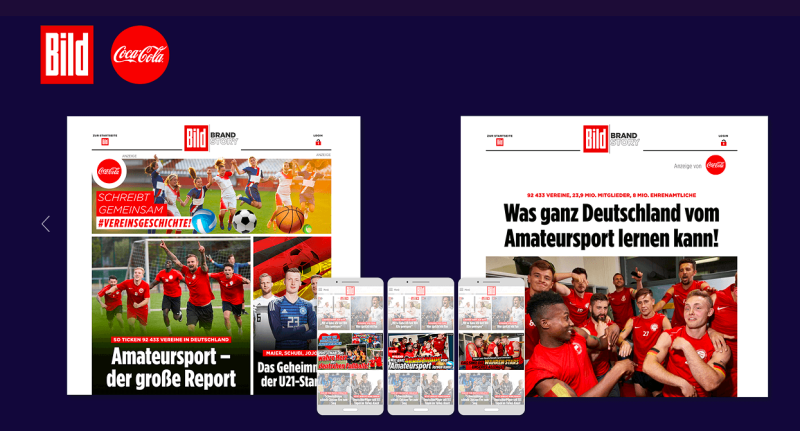
Native Ad Example 12: BBC Storyworks and Monash Business School
Choosing the right university can be a life-changing decision. Beyond courses, students seek institutions that thrive on innovation to help them make a bigger difference in the world.
Monash University teamed up with BBC StoryWorks, the content studio of BBC Global News, to showcase its bold history, clear vision, and what makes its Business School a smarter choice.
Together they created the content series, "Masters of Change", and told stories of Monash students, researchers, professors, and thought leaders through the lens of ground-breaking academia, specifically, in research.
The key take-out for the audience should be that by graduating from Monash, any student could become a master of change.
The content series consisted of five articles and a user-directed infographic available in a dedicated content hub. The infographic was ideal for Twitter, populating feeds with intriguing snippets about the future of work and evolving skill sets. Each article offered new perspectives on opportunities, collaborations, and ideas fostered by Monash Business School.
The Monash campaign delivered millions of impressions. The infographic was the stand-out performer with its attention-worthy content. The articles focusing on Antarctic research and how business schools are tackling global issues resonated with the target audience, resulting in high engagement and impressive dwell times.


